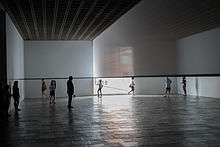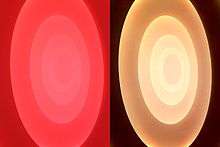Light art
Light art is an applied arts form in which light is the main medium of expression. It is an art form in which either a sculpture produces light, or light is used to create a "sculpture" through the manipulation of light, colors, and shadows. These sculptures can be temporary or permanent, and can exist in two distinctive spaces: indoor galleries, such as museum exhibits, or outdoors at events like festivals.
History

One of the earliest forms of light art is the transmission of light through stained glass, dating back to the 4th century. Stained glass is prominently featured in the elaborate windows of churches and mosques. Some famous examples of this include the Notre-Dame de Chartres Cathedral in France, the temples of Abu Simbel, the Great Pyramids in Egypt, and ancient Mayan and Aztec temples.
The Chinese took light art a step further with the invention of fireworks in the 9th century, playing on the use of light and color in an outdoor environment.

In shadow puppetry, projected shadows of puppets create moving images. A form of shadow puppetry is described as early as 380 BC by Plato in the Allegory of the Cave.
The interior of the Pantheon dome was possibly intended to symbolize the arched vault of the heavens.[1] The oculus also serves as a cooling and ventilation method. This architecture was very influential on James Turrell.
Modernism, Constructivism and the Bauhaus (1920–1935)
Light has been used for architectural effect throughout human history. However, the modern concept of light art emerged with the development of artificial electric incandescent light sources and experimentation by modern artists of the Constructivist and Bauhaus movements.[2] "Prounenraum (Proun room) (1923), by El Lissitzky, is considered by many art historians to be the first time an artist incorporated architectural lighting elements as a component integral to his work."[3][4] The first object-based light sculpture was the Light-Space Modulator (1922-1930), by László Moholy-Nagy (1895–1946).[5][6] Experimentation and innovations in theatrical light have often influenced other areas of light use such as light art. The development of Modernism and the electric light go hand-in-hand; the idea of the modern city with high-rises and electric light epitomizes this development.
All visual art uses light in some form, but in modern photography and motion pictures, use of light is especially important. However, with the invention of electrical artificial light, possibilities expanded and many artists began using light as the main form of expression, rather than solely as a vehicle for other forms of art. Constructivist Naum Gabo (1890-1977) experimented with the transparent materiality light reflects on an object; his Linear Construction No. 1 (1943) provides an example of this.[7] Marcel Duchamp's (1887-1968) Hat Rack (1916 and 1964), hangs from the ceiling and casts a shadow against the wall.[8]
Art critic Hilarie M. Sheets explains that "the interplay of dark and light has been a theme running from Greek and Roman sculpture to Renaissance painting to experimental film. But as technology advanced from the glow of the electric light bulb to the computer monitor, artists have been experimenting with actual light as material and subject."[9]
Lumino Kinetic and Op Art (1950–1970)
_-_BEIC_6365565.jpg)
Minimalism
Light art hit its peak in the 1960s, with artists such as Dan Flavin, François Morellet and Maurizio Nannucci creating interior sculptures and installations using such diverse media as neon tubes, diffuse lighting, and fluorescence.
Neon art (1980s)
In 1966, the Californian Light and Space Group, which included James Turrell, Robert Irwin, and Bruce Nauman, began developing light art using neon.[10]
Displays

Light projection
Closely associated art forms are projectors, 3-D map projection, multi-media, video art, and photography where light technology projects images rather than using light as the medium. Large light festivals and events have helped to develop the use of light on large canvases such as architectural facades, building projections, the flood lighting of buildings with colour, and interactive media facades. These forms of light art have their antecedents in new media-based, video art and photography which are sometimes classified as light art since light and movement are important to the work. Also included in the light art genre is the so-called light graffiti including projection onto buildings],[11] arrangement of lighted windows in buildings, and painting with hand-held lights onto film using time exposure.[12]
Museums

Many modern art museums include light sculptures and installations in their permanent and temporary collections. The Centre for International Light Art in Unna, Germany is currently the world's only museum dedicated exclusively to the collection and presentation of light art.[13][14]
The Light Art Museum in Eindhoven, Netherlands, another museum dedicated to the display of light art, closed on December 5, 2010[15] due to insufficient funding.
Many well-known art museums, such as the San Francisco Museum of Modern Art and the Museum of Modern Art in New York, often have temporary light art exhibits and installations in their galleries.[16][17][18]
Light festivals
Light festivals and the smart city LED revolution was driven by outdoor urban light sculpture with low energy LED luminaires. Light artists were able to create new exhibition spaces collectively in the form of light art festivals. These festivals have continued to grow internationally and help to highlight ecological change. This LED low energy movement dates back to the 2009 by the Vivid Smart Light Festival in Sydney.[19] In Singapore, the i Light Marina Bay festival—Asia's only sustainable light festival—was first hosted in 2010.[20] There are many light art festivals, especially in Europe, including the Signal Festival in Prague and the Ghent Light Festival. Light festivals and LEDS have redefined light art as an art genre.[21]
Light Art Awards
The International Light Art Award, presented by the Centre for International Light Art Unna and the RWE Foundation, is given to up-and-coming artists who will contribute "to the development of light art in an innovative and creative way"[22] and has been in existence since 2015.
The award is meant to encourage artists to explore light art, despite the difficulties the relatively new style faces, including the financial and technical requirements needed for a light art exhibit. The foundations behind the ILAA also wish to put emphasis on sustainability and new technologies within the medium of light expression.
The Australian and New Zealand Engineering Illumination Society ANZIES began giving an annual award to light artists at the Vivid Light Festival in 2010. The award consists of grants to help support local and international light artists in the pursuit of their medium.
The International Association of Lighting Design the IALD, a North American based organization, also gives out an annual award for light art.
The DARC awards, supported by Mondo Arc Magazine, began selecting winners for their light art award in 2015.
See also
- LED art
- Light Art Biennale Austria 2010
- Neon lighting and artists in light
- Snow lantern
- Lux Helsinki
References
- ↑ Wilson-Jones 2003, The Enigma of the Pantheon: The Interior, pp. 182–184
- ↑ Weibel, Peter; Jensen, Gregor, eds. (2006). Lichkunst aus Kunstlicht: Licht als Medium der Kunst im 20. und 21. Jahrhundert. ISBN 978-3-7757-1774-8. Catalog for an exhibition "Light Art from Artificial Light: Light as the Medium of Art in the 20th and 21st Centuries" at the Zentrum fur Kunst und Medientechnologie in Karlsruhe, Germany (November 19, 2005 - May 1, 2006).
- ↑ "light matters a closer look at the ideas behind their work" author Glen Shum
- ↑ "Replicas and Reconstructions in Twentieth-Century Art: El Lissitzky, Prounenraum 1923, reconstruction 1971". Tate. Retrieved 31 July 2016.
- ↑ cgroupid=999999961&artistid=1649&page=1&sole=y&collab=y&attr=y&sort=default&tabview=bio "László Moholy-Nagy, Tate bio" Check
|url=value (help). tate.org. - ↑ "Light Art". Kunstlexikon. Hatje Cantz Verlag. February 5, 2005. Retrieved 2011-01-17.
- ↑ "Linear Construction No. 1 1942–3". Tate. Retrieved 31 July 2016.
- ↑ "Hat Rack | The Art Institute of Chicago". www.artic.edu. Retrieved 2015-07-10.
- ↑ Sheets, Hilarie M. "Waves of Light." ARTnews Mar. 2007: 131-33. ARTnews. Print. Web. 1 Feb. 2012. http://www.artnews.com/2007/03/01/waves-of-light/.
- ↑ "Light and Space Movement". Artsy. Retrieved 31 July 2016.
- ↑ "Architectural Light Graffiti: Image Projection Bombing". Webist Media. Retrieved 31 July 2016.
- ↑ "Luminaries: 20 Light Graffiti Artists & Photographers". Webist Media. Retrieved 31 July 2016.
- ↑ "Take An Electrifying Look Inside The World's First Light Art Museum". Vice Media Inc. Retrieved 31 July 2016.
- ↑ "The World's Only Light Art Museum Grants the International Light Art Award 2015". International Year of Light 2015 - Blog. Retrieved 31 July 2016.
- ↑ "Closed: The Light Art Museum in Eindhoven", Luminapolis: The World of Lighting, November 28, 2010, retrieved 2016-01-17.
- ↑ "Jim Campbell". SFMOMA. Retrieved 2016-08-10.
- ↑ "Take your time: Olafur Eliasson | MoMA". The Museum of Modern Art. Retrieved 2016-08-10.
- ↑ "SFMOMA CELEBRATES ARTIST LEO VILLAREAL IN ANTICIPATION OF LIGHT INSTALLATION ON BAY BRIDGE". SFMOMA. Retrieved 2016-08-10.
- ↑ "Smart Light Sydney". Smart Light Sydney. Retrieved 31 July 2016.
- ↑ "i Light Marina Bay invites artists to submit proposals". Singapore Urban Redevelopment Authority. Retrieved 4 February 2016.
- ↑ "SuperLux: Smart Light Art, Design & Architecture for Cities" published by Thames and Hudson Author Davina Jackson
- ↑ NL,, Zentrum für Internationale Lichtkunst Unna // Design: RAW COLOR, Eindhoven,. "International Light Art Award". www.ilaa.eu. Retrieved 2016-08-08.
- Jansen, J. (1991), 'Het Electrisch': van lamplicht tot lichtsculptuur, Museum het Princessehof, ISBN 978-90-71588-10-5.
- Tahara, Keiichi (2001), Light, Sculpture, Photography, Editions Assouline, ISBN 978-2-84323-262-6.
- JanLeonardo Woellert & Joerg Miedza - Painting With Light: Light Art Performance Photography, Rocky Nook; 1 Edition (April 10, 2011), ISBN 978-1933952741
- Crisafulli, Fabrizio. 2013. Active Light. Issues of Light in Contemporary Theatre, Dublin: Artdigiland. ISBN 978-1494786922.
External links
| Wikimedia Commons has media related to Light art. |
- Centre for International Light Art (CILA), Unna
- International Forum of Light in Art and Design
- International Center for Contemporary Art dedicated to multimedia and light art
- Light art from Artificial Light
- Smashing Magazine Let There Be Light: Light Paintings and Sculptures
- Luceonline.it, the cultural portal of light and new technologies
- kunsthalle-detroit.org
- Oslo Lux